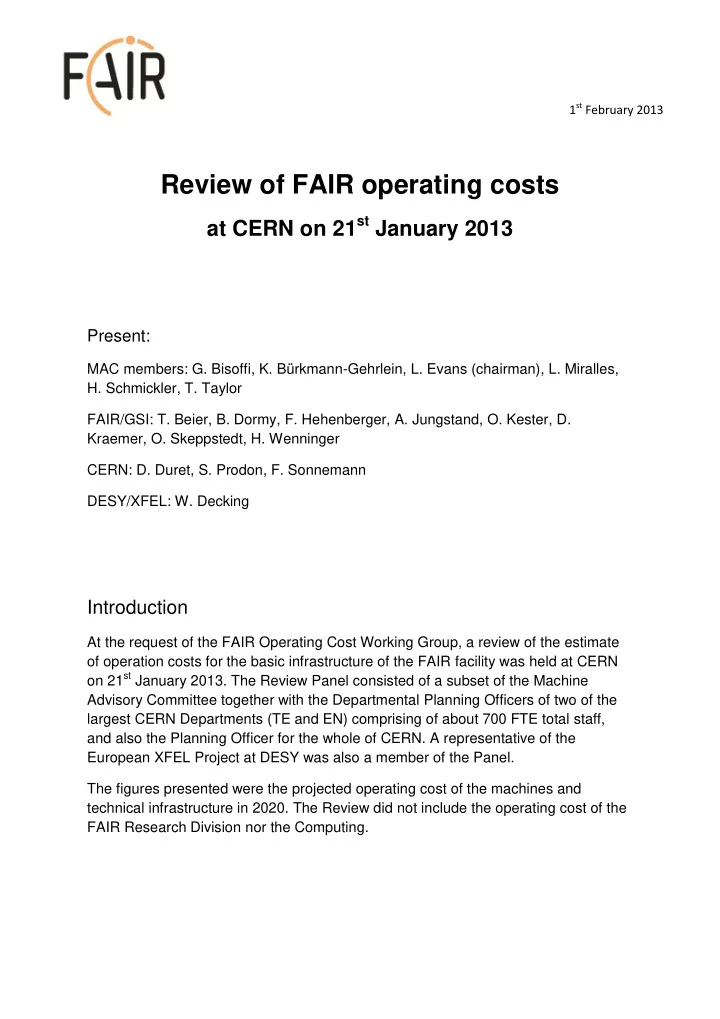

1 st February 2013 Review of FAIR operating costs at CERN on 21 st January 2013 Present: MAC members: G. Bisoffi, K. Bürkmann-Gehrlein, L. Evans (chairman), L. Miralles, H. Schmickler, T. Taylor FAIR/GSI: T. Beier, B. Dormy, F. Hehenberger, A. Jungstand, O. Kester, D. Kraemer, O. Skeppstedt, H. Wenninger CERN: D. Duret, S. Prodon, F. Sonnemann DESY/XFEL: W. Decking Introduction At the request of the FAIR Operating Cost Working Group, a review of the estimate of operation costs for the basic infrastructure of the FAIR facility was held at CERN on 21 st January 2013. The Review Panel consisted of a subset of the Machine Advisory Committee together with the Departmental Planning Officers of two of the largest CERN Departments (TE and EN) comprising of about 700 FTE total staff, and also the Planning Officer for the whole of CERN. A representative of the European XFEL Project at DESY was also a member of the Panel. The figures presented were the projected operating cost of the machines and technical infrastructure in 2020. The Review did not include the operating cost of the FAIR Research Division nor the Computing.
1 st February 2013 Methodology of the cost estimate D. Kraemer and O. Kester explained the methodology of the cost estimate. The budget is broken down into two components, Material and Personnel. Material The Materials budget is further expanded into 4 components, Goods and consumables, Electricity gas and water, Infrastructure maintenance and Miscellaneous. More than 40% of the materials budget is in the cost of electricity and it is difficult to predict the evolution of its cost over the next 10 years. The present cost of electricity at GSI is 11 ct/kWh of which 6 ct/kWh is directly for energy and the rest is for infrastructure fees. In the present estimate, it is assumed that the direct cost of electricity is doubled and the infrastructure cost is constant. This is consistent with the planning assumption at CERN for future energy cost. The total annual energy requirement of 250 GWh/year for running the facility is well defined so that even if the evolution of energy cost deviates from the planning assumption, this cost component is transparent. For maintenance costs, the estimate follows the directive of the German Ministry (AMEV directives). This requires 0.3% of the total construction cost for maintenance of buildings and 3% of investment cost of technical equipment. This is in line with the policy of depreciation at DESY for technical equipment although DESY has foreseen no budget for building maintenance. No upgrade costs or new projects are included. Personnel Quite a detailed breakdown of the manpower required to operate and maintain the facility was given. Whilst a few details could be challenged, for example some considered the number of FTE for radiation protection and safety to be too high whereas the number of shift operators is too low, the overall numbers are consistent with those required to run equivalent facilities at CERN and DESY. A consistency check could be made by calculating the average spend per FTE, dividing the materials budget of 96.7 M€ by the total FAIR estimate of 692 FTE (excluding the Research Division), giving 141 K€/FTE. This is remarkably close to the figures for maintenance, operation and consolidation in the two large CERN Departments with which it can best be compared.
1 st February 2013 There was some discussion of the projected average cost per FTE of 93.8 k€ in 2020. This figure seems to contain overheads other than direct salaries and social costs, making it difficult to compare with staff costs in other similar Institutions, particularly in DESY/XFEL. The FAIR Management was asked to clarify this point. The Panel considered that a budget of 2 M€ for Fellows is too low. This Programme is a source of bright young people who come for a limited duration and who constitute an invaluable pool of talent for future recruitment into the staff complement. Conclusions The Panel agrees with the methodology used to estimate the operating budget of the FAIR Facility excluding research and computing. The biggest uncertainty in the materials budget is the cost of electricity supply. However the estimate of annual energy requirement is quite solid so this element is very transparent as real energy costs evolve. The estimates on maintenance costs for accelerators, technical infrastructures and buildings are in line with the policy at CERN and at DESY Although there could be some discussion of the distribution of staff, particularly between accelerator shift operation and radioprotection and safety, the total number of FTE scales favourably with CERN experience. The assumed average full cost per FTE may be carrying some hidden overheads so should be checked for double counting.
Recommend
More recommend